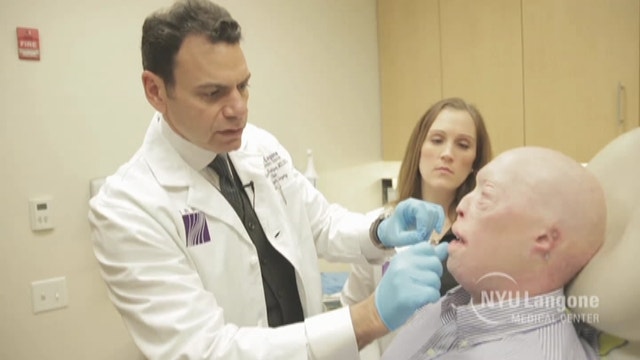Meet Doc behind world's most amazing face transplant
A team at NYU Langone Medical Center, led by Dr. Eduardo Rodriguez, recently performed the most complex and comprehensive face transplant to date in a 26-hour surgery beginning the morning of August 14, 2015.
The man who recently performed the most extensive face transplant in human history had not really planned to do so.
In fact, he used to be a dentist.
"I think the driving force for me was curiosity, and the ability to potentially do more," Dr. Eduardo Rodriguez, Chair of the Hansjörg Wyss Department of Plastic Surgery at NYU Langone Medical Center, told Fox News Latino.
In many ways, the field of face transplantation found Rodriguez. The son of Cuban exiles, Rodriguez was studying general surgery at Johns Hopkins and microsurgery in Taipei, Taiwan when he serendipitously witnessed a presentation by a well-known surgeon who explained how she transplanted the face of a brown rat to a white rat.
"I came back prepared with the ammunition to solve problems and at this point I felt that I really had an ability to take care of bigger problems," he said, as he began his career in face transplantation.
- Lizzie Velasquez, once ‘world’s ugliest woman,’ now among the bravest
- Firefighter gets new face in the most extensive transplant ever performed in the U.S.
- Parishioners from closed, yet thriving, New York City church hope for Pope Francis miracle
- Miracle in Mexico: Our Lady of Guadalupe Portrait Emerges Intact From Fire
- U.S. surgeons perform miracles in cash-strapped Venezuela
His opportunity to prove it came in the form of a letter, when a church friend reached out to him with a tragic story a couple of years ago. By then, in 2012, Rodriguez had already performed his first face transplant at the University of Maryland Medical Center.
In the letter, his friend told him the story of Patrick Hardison, a 41-year-old volunteer firefighter who was severely burned on Sept. 5, 2001 as he entered a burning house searching for a victim — the roof collapsed, giving him third-degree burns on his head, upper torso and neck.
Hardison had lost his ears, lips, most of his nose and vision - he had no eyelids. In the following 12 years he had undergone 71 surgeries, his friend told him in the letter.
Rodriguez agreed to try to help and put Hardison on a wait list.
After becoming head of NYU's Department of Plastic Surgery in 2013, Hardison's story followed Rodriguez.
Two years later, 26-year-old artist and competitive bicyclist David P. Rodebaugh died of injuries from a biking accident in New York City. He was an organ donor and, noting that he had always wanted to be a firefighter, his mother gave permission to use his face in the transplant.
On Aug. 14, Rodriguez led two teams of surgeons through a 26-hour surgery. Doctors had rehearsed seven times to practice the rigorous Frankenstein-like procedure, in which they took the face of Rodebaugh and transplanted on the bare bones and muscle tissues left on Hardison's face. The doctor had said there was about a 50-percent success rate.
The steady-spoken doctor says Hardison will eventually, with minor surgical procedures, look like the person he was prior to the burns — or close.
"For Patrick today he feels like he looks like the way he used to look before his injury," Rodriguez said. "When you give them a new face with normal features the new face of a donor begins to adapt to the skeleton of the recipient and that patient does begin to look like a blend between the donor and the recipient."
“You know what’s interesting about a person?” Rodriguez asks the five Hardison children in a video produced by NYU Langone Medical Center ahead of the groundbreaking surgery.
“Even though we change their face, what makes a person is who they are their voice, their mannerisms … and that’s what you begin to recognize as a person. “
Most importantly, Rodriguez told FNL, the surgery will give Hardison, a father of five, the ability to see clearly, which will allow him the independence he needs to drive and live without the help of others.
"I think ending up in this point is something that I never imagined," Rodriguez said while reflecting on the accomplishment.
A humble man, Rodriguez is now at the center of much media attention and he's using it as a platform to hopefully inspire others to push forward with their dreams.
"I didn't necessarily have the best pedigree, but I had a caring family who recognized the value of education," said Rodriguez, who is married to a Cuban woman.
"Nothing hard is ever easy in life. Some of the best things in life are the things we sweat the hardest for. Life is long, you can't have every step planned," he added. "You kind have to roll with the punches, but you have to have an idea of what kind of member of society you'd like to be."
Transforming lives one face at a time may not have been his initial intent, but now it has become his calling. He is forever thankful for his parents who fled Cuba to Miami for a better life, allowing him and his brothers to discover his full potential in the United States and to give back to a country who has given so much in return.
“I owe a great deal to this country and the individuals that protect our daily freedoms, those that we take for granted on a daily basis,” Rodriguez said.
“It's our responsibility to provide the best level of care to those wounded war fighters as well as our first responders, and that's why Patrick fit that bill perfectly.”
Contains reporting by the Associated Press.

